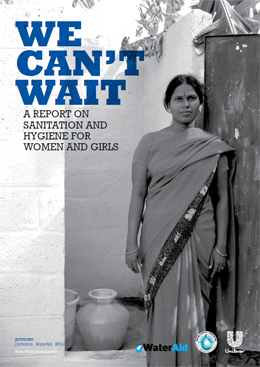Navigation
Realizing Water, Sanitation and Hygiene for All
- blindness
- CDC
- cholera
- Diarrhea
- hygiene
- malnutrition
- neglected tropical diseases
- Oral rehydration solution
- sanitation
- Schistosomiasis
- shigellosis
- soil-transmitted helminths
- trachoma
- UN
- undernutrition
- WASH
- WHO
- World Bank
- World Health Organization
- World Toilet Day
- Global Health
- Pollution
- Public Health
- Sanitation
- Water
- Water and Sanitation
This article focuses on the background of the problem, what it means for nearly half the people of the developing world who lack adequate sanitation and hygiene. Today, an estimated 2.4 to 2.6 billion individuals lack access to any type of improved sanitation facility according to the World Health Organization (WHO). According to the Centers for Disease Control and Prevention (CDC) half of the developing world, more than 35 % of the world’s population lack access to adequate sanitation. And, poor sanitation and hygiene are inextricably linked to water quality.
This is Part One of a Series of Articles. The first focuses on the background of the problem, what it means for nearly half the people of the developing world who lack adequate sanitation and hygiene.
 Happy children: Photograph by Jay Graham
Happy children: Photograph by Jay Graham
“…once we can secure access to clean water and to adequate sanitation facilities for all people, irrespective of the difference in their living conditions, a huge battle against all kinds of diseases will be won,” said the late Dr. Lee when he was Director-General of the World Health Organization.
“BMJ readers choose the ‘sanitary revolution’ as greatest medical advance since 1840… Almost a third of the voters were doctors,” reported the British Medical Journal in its article published on 18 January 2007. “The original champions of the sanitary revolution were John Snow, who showed that cholera was spread by water, and Edwin Chadwick, who came up with the idea of sewage disposal and piping water into homes.”
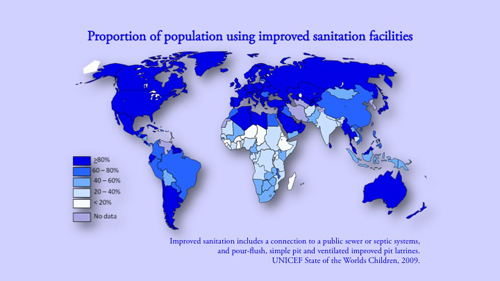 An estimated 2.4 to 2.6 billion individuals lack access to any type of improved sanitation facility according: to the World Health Organization.
An estimated 2.4 to 2.6 billion individuals lack access to any type of improved sanitation facility according: to the World Health Organization.
Today, an estimated 2.4 to 2.6 billion individuals lack access to any type of improved sanitation facility according to the World Health Organization (WHO). According to the Centers for Disease Control and Prevention (CDC) half of the developing world, more than 35 % of the world’s population lack access to adequate sanitation. And, poor sanitation and hygiene are inextricably linked to water quality.
What does it mean to not have a toilet?
Women and girls suffer particularly much from the lack of toilets and hygiene. “One in three women worldwide risk shame, disease, harassment and even attack because they have nowhere safe to go to the toilet and 526 million women have no choice but to go to the toilet out in the open. Women and girls living without any toilets spend 97 billion hours each year finding a place to go.”
These and other stark consequences for women and girls of the lack of access to toilets or use of good hygiene practices are highlighted in We Can’t Wait, a new report jointly published by the United Nations hosted organisation Water Supply and Sanitation Collaborative Council (WSSCC), international development organisation WaterAid and Unilever’s leading toilet brand Domestos that was presented at a UN World Toilet Day event in New York.
“The lack of this most fundamental service contributes to an estimated 1.87 million annual deaths due to diarrhea- more than 90 % of which are in children under 5 years of age,” writes Jay Graham, Assistant Professor and Director of the MPH in Global Environmental Health at the George Washington University School of Public Health and Health Services in the book, Water and Sanitation Related Diseases and the Environment: Challenges, Interventions and Preventive Measures, a Wiley-Blackwell collaboration with Horizon International (the “Book”).
Diarrhea remains the second leading cause of death in children under 5 years of age globally, and nearly one in five child deaths, around 1.5 million a year, is due to diarrhea. This equates to the death of one child every 15 seconds, meaning more than 4,000 child deaths every day, and exceeds the death rates from such killer diseases as malaria and tuberculosis according to the World Bank.
Diarrhea kills more children than AIDS, malaria and, measles combined.
Additionally, nearly 1 billion people worldwide are infested with intestinal worms and as a result suffer nutritional deficiencies and poor growth. Exposure to feces – primarily human – is at the core of these diseases.
Graham writes that “Sanitation and hygiene are among the most cost-effective interventions for reducing the economic impacts of disease…in most economically developing countries the main source of contaminated water is fecal contamination… there is growing recognition that environmental health interventions such as sanitation and hygiene must be more fully integrated into mainstream development policies because of the strong linkages to malnutrition and poverty reduction.”
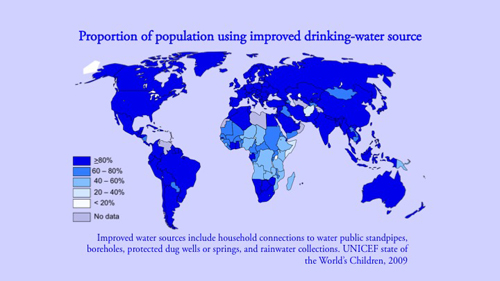 1.2 billion individuals are exposed to water-related illness from their drinking water
1.2 billion individuals are exposed to water-related illness from their drinking water
With roughly 884 million people lacking access to an improved water supply, water that is protected from outside contamination, in particular from contamination with fecal matter, 1.2 billion individuals are exposed to water-related illness from their drinking water.
In addition to diarrhea, malnutrition, Schistosomiasis, blindness from trachoma and many other illnesses are attributable to lack of adequate sanitation and hygiene.
Over 10 million deaths and 250 million new cases of waterborne disease occur yearly.
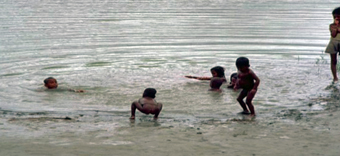 Children playing in a pond outside their village in Bangladesh.: Photograph courtesy of Michael L Bennish and M. John Albert from the chapter “Shigellosis” in the Book.
Children playing in a pond outside their village in Bangladesh.: Photograph courtesy of Michael L Bennish and M. John Albert from the chapter “Shigellosis” in the Book.
In most developing countries the main source of contaminated water is fecal contamination --particularly a problem where 1.1 billion people still practice open defecation.
In spite of the realization of the magnitude of children, women and men lacking sanitation far too little has thus far been done.
Recognizing the devastating health consequences, the suffering from indignity and frequent exposure, particularly for women and girls, to danger, there is a dramatic increase in efforts addressing sanitation and hygiene, the United Nations, NGOs and governments are increasing their commitment of resources to sanitation and hygiene.
For example, the Water Supply and Sanitation Collaborative Council (WSSCC), is dedicating the vast majority of its effort to sanitation and hygiene, while continuing some work on water. “The rationale for this decision is simple: 2.5 billion people - or about 40% of the world’s population - do not have access to basic sanitation,” WSSCC asserts. “These numbers shame humanity. The consequences in terms of human suffering and economic loss are enormous.”
With its first official observance of World Toilet Day, on 19 November 2013, the United Nations called on the international community to help break taboos around toilets, which are still out of reach to more than one-third of the global population, and make sanitation a global development priority.
World Toilet Day, message from the UN Deputy Secretary-General
The United Nations Deputy Secretary-General, Mr. Jan Eliasson, explains that one third of humanity lacks access to improved sanitation, such as toilets or latrine, leading to dramatic consequences on human health, dignity and security, but also on the environment, and on social and economic development.
From the United Nations, 19 November 2013
“Despite the compelling moral and economic case for action on sanitation, progress has been too little and too slow,” Secretary-General Ban Ki-moon said in his message for the Day, noting that sanitation is central to human and environmental health, and essential for sustainable development, dignity and opportunity.
The United Nations Special Rapporteur on the human right to safe drinking water and sanitation, Catarina de Albuquerque, commented on the first UN World Toilet Day “that the sanitation target set by the UN Millennium Development Goals (MDG) is the most off-track of all, leaving around one billion people still practicing open defecation on a daily basis, and one-third of the world’s population without access to improved sanitation.”
“This is a euphemism to describe the undignified life of billions of people who have no place to defecate or urinate and have to do it without conditions of safety, hygiene, privacy or dignity,” Ms. de Albuquerque said, adding that “Eighty three per cent of countries have fallen significantly behind the national targets they have set for sanitation.”
“Adopting the resolution, the 193-member Assembly urged UN Member States and relevant stakeholders to encourage behavioral change and the implementation of policies to increase access to sanitation among the poor, along with a call to end the practice of open-air defecation, which it deemed “extremely harmful” to public health.
The resolution also recognizes the role that civil society and non-governmental organizations play in raising awareness of this issue. It also calls on countries to approach sanitation in a much broader context that includes hygiene promotion, the provision of basic sanitation services, and sewerage and wastewater treatment and reuse in the context of integrated water management.
The greatest number of people without access to improved sanitation is in southern Asia, but there are also large numbers in eastern Asia and sub-Saharan Africa. Seven out of 10 people without basic sanitation live in rural areas.
Most infectious diarrhea episodes are acute in nature, and can lead to rapid loss of bodily fluids, dehydration, and death if proper supportive care is not provided.
“Deaths due to diarrhea occur almost exclusively in low- and middle-income countries due to lack of access to appropriate medical care, countries where WHO estimates that in 2004 over 99% of deaths due to diarrhea occurred.”
What are the main causes of infectious diarrhea?
“The majority of diarrheas are gastrointestinal infections caused by viral, bacterial, and parasitic pathogens which disrupt the gut’s normal secretion and absorption functions,” write co-authors Sean Fitzwater, Aruna Chandran, Margaret Kosek, and Mathuram Santosham of Johns Hopkins Bloomberg School of Public Health (JHSPH) in the Book.
The viruses include rotavirus, Calicivirus, measles, and adenovirus, bacteria include Vibrio cholera, Escherichia coli, shigella and salmonella, and parasitic pathogens include cryptosporidium and Giardia lamblia.
“Globally, most disease and death caused by bacterial diarrhea are the result of E. coli, Shigella, V. Cholera, Salmonella, and Campylobacter infections. Bacteria, much more than viruses, have a strong association with poor sanitary conditions and are exclusively transmitted by the fecal-oral route. …Some bacteria, notably Clostridium difficile, cause significant disease in patients with preexisting medical conditions, which has been documented predominantly in developed countries.”
“Multiple factors are associated with increased risk of diarrheal diseases, including lack of access to clean water, inadequate disposal of human waste, overcrowding, limited quality control in food handling and processing, and malnutrition. As a result, the burden of diarrheal illnesses varies widely globally.
“Repeated bouts of acute diarrhea can exasperate malnutrition and lead to poor growth, impaired immune function, and increased susceptibility to diarrhea as well as other infections.”
“Fortunately, most infectious diarrhea can be successfully managed. Uncomplicated diarrhea can be easily managed with a simple regimen of oral rehydration and nutritional therapies, while severe dehydration may require intravenous (IV) fluids; for cholera or dysenteric diarrhea, such as shigellosis, antibiotics are recommended in addition to rehydration.”
Oral rehydration solution (ORS), described in the Harvard School of Public Health’s (HSPH) Special Centennial Issue, fall 2013, as “A Simple Solution that has saved millions,” is a solution of table salt, sodium bicarbonate, glucose, and water, that was described in “a landmark paper published in The Lancet in 1968,” by Richard Cash HSPH Senior Lecturer and his colleagues. “A simplified form of ORS –made up of a pinch of salt, a fistful of sugar, and half a liter of clean water –has been taught to millions of mothers to treat children at home.”
Pathogenic microorganisms including viruses -- rotovirus, measles, norovirus, bacteria-- E-coli, shigella, salmonella, vibrio cholera, and campylobacter, and parasitic pathogens – cryptosporidium and giardia lamblia are, among others, capable of causing infection in humans.
Cholera
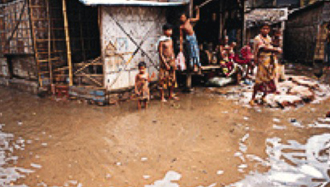 Family standing in polluted water.: Photograph courtesy of CDC.
Family standing in polluted water.: Photograph courtesy of CDC.
“Throughout history,” Fitzwater et al write in the Book, “cholera has occurred in settings of extreme poverty, natural disasters, and wars, where case fatality may exceed 20%.
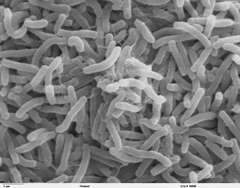 Vibrio cholerae: Scanning electron microscope (SEM)"It is caused by ingesting Vibrio cholera, Gram-negative bacteria that naturally reside in brackish rivers and coastal waters.
Vibrio cholerae: Scanning electron microscope (SEM)"It is caused by ingesting Vibrio cholera, Gram-negative bacteria that naturally reside in brackish rivers and coastal waters.
"V. cholera is present in fecally contaminated water or food.”
Reports on the devastating conditions in Haiti, provide stark reminders of the rapidity with which cholera spreads, and, if not met with emergency response.
In the aftermath of the devastating earthquake in Haiti, in late October 2010 a major cholera epidemic struck. Since then, according to Doctors without Borders, MSF, “More than 500,000/half a million cases of cholera were recorded … Nearly 170,000 patients with cholera symptoms were treated between October 2010 and November 2011… At the height of the crisis, some 4,000 health care providers were working at more than 75 facilities in Haiti. One in 20 Haitians were ill and more than 7,000 people died.
As a preventive measure Partners in Health launched the Haiti Cholera Vaccine Project to vaccinate 50,000 people against this terrible disease in a vulnerable rural rice-growing community.
Cholera has a short incubation period, from less than one day to five days, and produces a toxin causing vomiting and diarrhea. The resulting watery diarrhoea that can quickly lead to severe dehydration and death if treatment is not promptly given.
According to WHO, “Cholera remains a global threat and is one of the key indicators of social development. While the disease no longer poses a threat to countries with minimum standards of hygiene, it remains a challenge to countries where access to safe drinking water and adequate sanitation cannot be guaranteed. Almost every developing country faces cholera outbreaks or the threat of a cholera epidemic.”
Haiti’s cholera outbreak provides a stark example of failure to provide for clean water and sanitation. With millions of dollars in aid received over the last few years to help earthquake and, now, Hurricane Sandy victims, and more than half a million cases of cholera and 7,500 deaths reported, conditions remain dire in large part because of the failure.
Anemia, Malnutrition and Undernutrition
Infections related to hygiene, sanitation, unsafe water and inadequate water management are significant contributors to anemia in addition to nutritional deficiencies. Of the 2 billion people who suffer from anemia, nine out of ten live in developing countries. Anemia may contribute to up to 20% of maternal deaths, according to WHO.
 Child suffering with Marasmus (extreme emaciation) in India: Photograph courtesy of the CDCWater and sanitation-related illness is further aggravated by nutritional inadequacies and infections, problems that often exist in the same person. As Dr. Jeffrey Griffiths points out, in the “Book,” malnutrition and diarrhea have long been known to form a destructive cycle: malnutrition increases the susceptibility of children to pathogens that cause diarrhea and other disease, diarrhea decreases the gut’s ability to absorb nutrients, leading to malnutrition.
Child suffering with Marasmus (extreme emaciation) in India: Photograph courtesy of the CDCWater and sanitation-related illness is further aggravated by nutritional inadequacies and infections, problems that often exist in the same person. As Dr. Jeffrey Griffiths points out, in the “Book,” malnutrition and diarrhea have long been known to form a destructive cycle: malnutrition increases the susceptibility of children to pathogens that cause diarrhea and other disease, diarrhea decreases the gut’s ability to absorb nutrients, leading to malnutrition.
Malnutrition and under nutrition which cause anemia, the main cause of which is iron deficiency, the most prevalent nutritional deficiency in the world, occurs when not enough red blood cells carry oxygen to the tissues in the body.
Infections related to hygiene, sanitation, unsafe water and inadequate water management are significant contributors to anemia in addition to nutritional deficiencies. Of the 2 billion people who suffer from anemia, nine out of ten live in developing countries. Anemia may contribute to up to 20% of maternal deaths, according to WHO.
Shigellosis
“With humans as its only host, and with the gut as its place of residence within humans, infections with Shigella –the causative agent of shigellosis- are the primary result of fecal-oral spread via contaminated food or fomites,” write Dr. Michael L Bennish of Johns Hopkins University and Dr. M. John Albert of Kuwait University in the Book.
“Crowding and lack of sanitation in field conditions has caused major affliction of armies --at times severe enough to affect the outcome of battles.
 Characteristic dysenteric stool of a patient with shigellosis, containing blood, mucus and small amounts: of fecal matter. Photograph courtesy of Michael L Bennish and M. John Albert from the chapter “Shigellosis” in the Book."Shigellosis is the archetype of a disease resulting from poor personal and environmental hygiene and sanitation. Despite the high-tech nature of many modern armies, shigellosis continues to be a major problem, being the second most common cause of diarrhea among U.S. military personnel during the recent Iraq war.
Characteristic dysenteric stool of a patient with shigellosis, containing blood, mucus and small amounts: of fecal matter. Photograph courtesy of Michael L Bennish and M. John Albert from the chapter “Shigellosis” in the Book."Shigellosis is the archetype of a disease resulting from poor personal and environmental hygiene and sanitation. Despite the high-tech nature of many modern armies, shigellosis continues to be a major problem, being the second most common cause of diarrhea among U.S. military personnel during the recent Iraq war.
“Shigella, best known for causing dysentery, responsible for 30-50 % of all cases, causes an unacceptably large number of deaths worldwide—estimated at more than 1,000,000 annually primarily among malnourished children,” write Bennish and Albert.
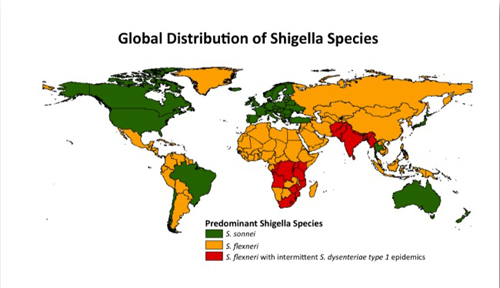
“ Increasing affluence is associated with a diminution in the incidence and severity of Shigella infections.”
Bacterial contamination, for example with E. coli
In the US, the government estimates that One in six Americans becomes ill from eating contaminated food each year.
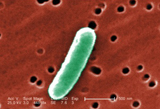 Escherichia coli (E. coli): Content provider: CDC/ Janice Haney Carr Source: CDC, Public Health Image Library Image ID # 10577The Food and Drug Administration recently called for rules that could prevent about 1.75 million illnesses each year. As the New York Times reported, “Farmers would have to ensure that water used in irrigation met certain standards and food processors would need to find ways to keep fresh food that may contain bacteria from coming into contact with food that has been cooked.
Escherichia coli (E. coli): Content provider: CDC/ Janice Haney Carr Source: CDC, Public Health Image Library Image ID # 10577The Food and Drug Administration recently called for rules that could prevent about 1.75 million illnesses each year. As the New York Times reported, “Farmers would have to ensure that water used in irrigation met certain standards and food processors would need to find ways to keep fresh food that may contain bacteria from coming into contact with food that has been cooked.
"The second rule would apply to the harvesting and production of fruits and vegetables in an effort to combat bacterial contamination like E. coli, which is transmitted through feces."
"Field workers often lack toilets and facilities for hand washing. The rules would address “four Ws” — water, waste, workers and wildlife.”
We depend on good microbes while our bodies fight against the bad ones.
“Your digestive system alone is host to more than a hundred trillion microbes, of at least four hundred types…” writes popular science author Bill Bryson in A Short History of Nearly Everything. “Every human body consists of about ten quadrillion cells, but is host to about a hundred quadrillion bacterial cells.”

The New York Times account of January 16, 2013, reads, “The treatment appears to work by restoring the gut’s normal balance of bacteria, which fight off C. difficile.” Stool can contain hundreds or even thousands of types of bacteria, and researchers do not yet know which ones have the curative powers. So for now, feces must be used pretty much intact.”
Schistosomiasis
 Snails, disease vectors for Schistosomiasis a disease endemic in almost 80 countries in the Americas, Africa and Asia,: with an especially high burden of infection and disease on the African continent especially in sub-Saharan countries. This image is from the video "kill or Cure: Bilharzia produced by Rockhopper TV, courtesy of the Schistosomiasis Control Initiative (SCI) as appears in the DVDs that accompany the Book.
Snails, disease vectors for Schistosomiasis a disease endemic in almost 80 countries in the Americas, Africa and Asia,: with an especially high burden of infection and disease on the African continent especially in sub-Saharan countries. This image is from the video "kill or Cure: Bilharzia produced by Rockhopper TV, courtesy of the Schistosomiasis Control Initiative (SCI) as appears in the DVDs that accompany the Book.
Other water-related diseases, such as Schistosomiasis, a helminth or parasitic worm infection, infect humans by skin contact with contaminated water. “Schistosomiasis, a fresh-water-related, helminth infection, is considered the second most important parasitic infection after malaria in terms of public health impact, write Drs. Pascal Magnussen and Birgitte Jyding Vennervald of the Faculty of Life Sciences at the University of Copenhagen and Jens Aagaard-Hansen Head of Prevention Research at the Steno Diabetes Center in Denmark, in the Book. “It is endemic in almost 80 countries in the Americas, Africa and Asia, with an especially high burden of infection and disease on the African continent especially in sub-Saharan countries.”
Approximately 600-700 million people are estimated to be at risk of infection and approximately 160-200 million individuals to be infected. Mortality figures for schistosomiasis are difficult to estimate because death due to schistosomiasis rarely takes place in health facilities, but in sub-Saharan Africa figures between 20,000 and 200,000 per year have been suggested.
Schistosomiasis: Ending the Anguish of a Silent Disease (The Carter Center)
“Parasite eggs are excreted via the feces or urine. The eggs hatch in freshwater to release miracidia, which locate snail vectors, where asexual multiplication with formation of sporocysts occurs…After approximately five weeks, large numbers of cercariae, the larval stage, are shed into the water and people are infected when the cercariae [larvae] penetrate intact skin.
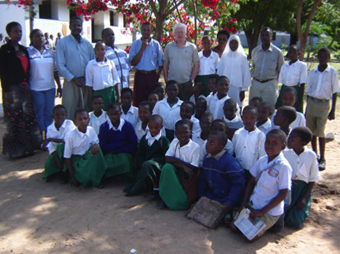 School children coming for examination for S. mansoni infection at school, Magu district, Tanzania: Photograph by Dr. Pascal Magnussen
School children coming for examination for S. mansoni infection at school, Magu district, Tanzania: Photograph by Dr. Pascal Magnussen
“People come into contact with water containing infectious larvae for a wide rage of reasons, including washing themselves or their clothes and collecting water for drinking or cooking or for irrigation.
"Among children, playing or swimming in water is an important activity, while some adults, such as fishermen, car washers, canal cleaners, or people working in irrigation schemes or rice fields, my have high occupational exposure.”
Trachoma: Blindness is one of the tragic results of poverty and poor sanitation and hygiene.
Trachoma is the most common form of blindness with over 40 million people in the poorer developing world with active infections.
Blindness is one of the tragic results of poverty, poor hygiene, and the availability of water,” write Dr. Joseph A. Cook of the University of North Carolina and former Executive Director of the International Trachoma Initiative and Dr. Silvio P. Mariotti, of the World Health Organization in the Book. “Fortunately, with improving socioeconomic conditions, including especially access to water and improved hygiene, trachoma as a cause of blindness is absent from industrialized countries.”
Trachoma is found in 57 countries. An estimated 40.6 million people are suffering from active trachoma and 8.2 million are estimated to have the condition that leads to blindness.
The Carter Center says that 500 million people are at risk.
The Carter Center's Trachoma Control Program
The role of water and sanitation in the transmission and control of blinding trachoma are listed as “Facial Cleanliness and Environmental Change” as part of the SAFE strategy devised by WHO. These are two of the proven strategies along with surgery to halt corneal damage and antibiotic treatment.
The Carter Center program encouraging improved hygiene became so popular in Ethiopia that more than 345,000 latrines built in only a few years. The story of the Center’s effort is presented in this video.
Soil-transmitted helminths [or STH] are a major global pubic health problem.
There are nearly 1 billion people worldwide infested with intestinal worms,
as a result of which they suffer nutritional deficiencies and poor growth.
WHO Facts and Figures for Intestinal helminths (Ascariasis, Trichuriasis, Hookworm) for 2004:
• 133 million people suffer from high intensity Intestinal helminths infections, which often leads to severe consequences such as cognitive impairment, massive dysentery, or anaemia.
• These diseases cause around 9400 deaths every year.
• Access to safe water and sanitation facilities and better hygiene practice can reduce morbidity from Ascariasis by 29% and hookworm by 4%.
“Soil-transmitted helminths [or STH] are a major global pubic health problem,” Dr. Brian G. Blackburn, Clinical Associate Professor, Medicine - Infectious Diseases, Stanford University School of Medicine and Dr. Michele Barry, Senior Associate Dean for Global Health and Director of Global Health Programs in Medicine at Stanford write. “The most important impact globally is the association between STH infection and the adverse outcomes in infected young children, who suffer anemia, impaired growth, and impaired cognitive development.
"This is another cause of anemia in pregnant women and results in poor pregnancy outcomes.
"Soil-transmitted helminth infections are considered among the “neglected tropical diseases.”
The neglect arises because the people most affected by these diseases are the world’s most impoverished, particularly those who subsist on less than $2 per day.
Which diseases are considered Neglected Tropical Diseases?
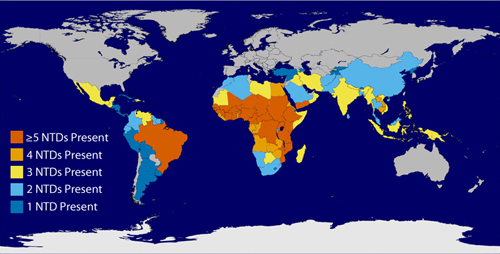 Global Overlap of Six of the Common Neglected Tropical Diseases (NTDs):: Specifically guinea worm disease, lymphatic filariasis, onchocerciasis, schistosomiasis, soil-transmitted helminths, trachoma. Soil-transmitted helminth infections can be caused by three different worms, all treated the same way. Image Courtesy Division of Parasitic Diseases, Centers for Disease Control and Prevention (CDC) (NTDs), a group of infectious diseases, include:
Global Overlap of Six of the Common Neglected Tropical Diseases (NTDs):: Specifically guinea worm disease, lymphatic filariasis, onchocerciasis, schistosomiasis, soil-transmitted helminths, trachoma. Soil-transmitted helminth infections can be caused by three different worms, all treated the same way. Image Courtesy Division of Parasitic Diseases, Centers for Disease Control and Prevention (CDC) (NTDs), a group of infectious diseases, include:
• Dracunculiasis (Guinea Worm Disease)*
• Soil-transmitted Helminths (STH) (Ascaris, hookworm, and whipworm)*
• Trachoma*
* Disease is controllable by mass drug administration (MDA) or effective intervention **Soil-transmitted helminth infections can be caused by three different worms, all treated the same way.
Content from the map is available here and at (http://www.cdc.gov/globalhealth/ntd/diseases/ntd-worldmap-table.html).
Sanitation, once again, is a factor closely interrelated with transmission of the soil-transmitted helminths.
The most common of the soil-transmitted helminth infections is Ascariasis lumbricoides with a prevalence of about one billion people globally, mostly people living in the tropics.
“Eggs are passed in the feces of infected persons…” Once they reach a favorable environment of warm, moist soil they develop, becoming infectious. Humans usually acquire the infection by ingestion of these eggs via contaminated food (or water).
Visualize what happens when these worms enter the human body?
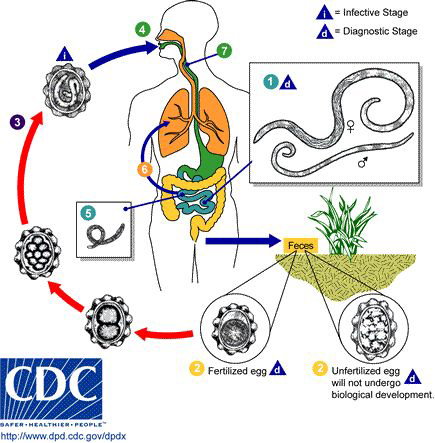 Ascariasis lumbricoides in the human body: Image courtesy of the CDC
Ascariasis lumbricoides in the human body: Image courtesy of the CDC
 A. lumbricoides egg:: Image Courtesy Division of Parasitic Diseases/Centers for Disease Control and Prevention
A. lumbricoides egg:: Image Courtesy Division of Parasitic Diseases/Centers for Disease Control and Prevention
The eggs hatch in the small intestine and migrate to the lungs.
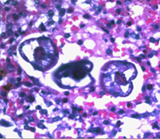 A. lumbricoides larvae in lung tissue:: Image Courtesy Division of Parasitic Diseases/Centers for Disease Control and Prevention
A. lumbricoides larvae in lung tissue:: Image Courtesy Division of Parasitic Diseases/Centers for Disease Control and Prevention
They then ascend the tracheobronchial tree, are swallowed, and return to the intestines.
 Adult A. lumbricoides worm:: Image Courtesy Division of Parasitic Diseases/Centers for Disease Control and Prevention
Adult A. lumbricoides worm:: Image Courtesy Division of Parasitic Diseases/Centers for Disease Control and Prevention
There they mature into adult worms.
About 2 months after infection, egg production begins. Each day of their one of two year life, one adult can produce over 200,000 eggs.
Ascariasis was once highly prevalent in Europe, with elimination aided by the implementation of sanitation and sewage systems.
Barry and Blackburn note “Fortunately, over the past 5-10 years, the global community has begun to recognize the importance of these infections.”
“Integration of soil-transmitted helminth control and elimination programs with other such programs directed at parasites (such as lymphatic filariasis, onchocerciasis, schistosomiasis, and malaria) may be the way forward. Increasing public and private advocacy for this approach has been building over the last few years, and has the advantage of addressing multiple public health problems with fewer resources than each would require individually. Using existing infrastructure to deliver multiple interventions reduces costs and takes advantage of access to communities already in place.
“However, although they may lower the prevalence and intensity of STH infections, such programs are unlikely to eliminate transmission in the absence of the adjunctive factors… such as improved sanitation, clean water supplies, and economic development.”
For example, write Barry and Blackburn, “Poverty reduction and improved economic development have probably done more to eliminate hookworm in industrialized nations than any other single factor, including sanitation, anti-helminthics, footwear, and health education.
“Economic development with improvement in living standards and the introduction of piped water, sewage systems, mechanized agriculture, and elimination of night soil are largely responsible for the control of hookworm infection in North America, Europe, Japan, and Korea.
“These measures would most likely be effective in many developing countries.
Education regarding the proper use of sanitation facilities and the avoidance of using night soil is also essential.”
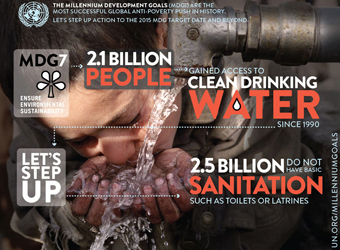 Millennium Development Goal 7 (Ensure Environmental Sustainability), Target 7.c: halve, by 2015,: the proportion of the population without sustainable access to safe drinking water and basic sanitation.
Millennium Development Goal 7 (Ensure Environmental Sustainability), Target 7.c: halve, by 2015,: the proportion of the population without sustainable access to safe drinking water and basic sanitation.
According to the United Nations’ Statement on World Toilet Day, “Of the eight anti-poverty targets known as the Millennium Development Goals (MDGs), the sanitation target is the most off-track with more than 80 per cent of countries behind in the national targets that they set.
While six billion people worldwide have mobile phones, only 4.5 billion have access to toilets or latrines – meaning that 2.5 billion people, mostly in rural areas, do not have proper sanitation, according to UN figures. In addition, 1.1 billion people still defecate in the open.
According to a joint UNICEF and World Health Organization report this year, the largest number of these people are in India (626 million), followed by Indonesia (63 million), Pakistan (40 million), Ethiopia (38 million), and Nigeria (34 million).
Poor water and sanitation cost developing countries around $260 billion a year - 1.5 per cent of their gross domestic product (GDP), the UN reported, while every dollar invested could bring a five-fold return by keeping people healthy and productive.
Improved Sanitation and Hygiene Will Make Lives Better and Save lives
The difference that successful measures can make is strikingly significant. Considering diarrhea, according to WHO, “Improvements in drinking-water quality through household water treatment, such as chlorination at point of use, can lead to a reduction of diarrhea episodes by as much as 39%... “Improved sanitation reduces diarrhoea morbidity by 32%.”
These are facts from the WHO from November 2004 (note: some of these figures vary from the previously mentioned figures in this article which are more recent):
Diarrhoea
- 1.8 million people die every year from diarrhoeal diseases (including cholera); 90% are children under 5, mostly in developing countries.
- 88% of diarrhoeal disease is attributed to unsafe water supply, inadequate sanitation and hygiene.
- Improved water supply reduces diarrhoea morbidity by between 6% to 25%, if severe outcomes are included.
- Improved sanitation reduces diarrhoea morbidity by 32%.
- Hygiene interventions including hygiene education and promotion of hand washing can lead to a reduction of diarrhoeal cases by up to 45%.
- Improvements in drinking-water quality through household water treatment, such as chlorination at point of use, can lead to a reduction of diarrhoea episodes by between 35% and 39%.
Schistosomiasis
An estimated 160 million people are infected with schistosomiasis.
- The disease causes tens of thousands of deaths every year, mainly in sub-Saharan Africa.
- It is strongly related to unsanitary excreta disposal and absence of nearby sources of safe water.
- Basic sanitation reduces the disease by up to 77%.
- Man-made reservoirs and poorly designed irrigation schemes are main drivers of schistosomiasis expansion and intensification.
Trachoma
- 500 million people are at risk from trachoma.
- 146 million are threatened by blindness.
- 6 million people are visually impaired by trachoma.
- The disease is strongly related to lack of face washing, often due to absence of nearby sources of safe water.
- Improving access to safe water sources and better hygiene practices can reduce trachoma morbidity by 27%.
Intestinal helminths (Ascariasis, Trichuriasis, Hookworm
- 133 million people suffer from high intensity Intestinal helminths infections, which often leads to severe consequences such as cognitive impairment, massive dysentery, or anaemia.
- These diseases cause around 9400 deaths every year.
- Access to safe water and sanitation facilities and better hygiene practice can reduce morbidity from ascariasis by 29% and hookworm by 4%.
Positive Developments are covered in the next Parts of this Series with a focus on the achievements of the WSSCC with its collaborators and of the Sulabh International Social Service Organization.
“There are significant differences both spatially and socially between groups who are making progress [in having access to sanitation] and those who are falling behind," writes Jay Graham, Assistant Professor and Director of the MPH in Global Environmental Health at the George Washington University School of Public Health and Health Services in the Book." The greatest number of people without access to improved sanitation is in southern Asia, but there are also large numbers in eastern Asia and sub-Saharan Africa. Seven out of 10 people without basic sanitation live in rural areas. There are positive developments, however.
"Major gains in sanitation coverage have been made in northern Africa, southeastern Asia, and eastern Asia. Furthermore, open air defecation—the riskiest sanitation practice—is on the decline worldwide, with a global decrease from 25% in 1990 to 17% in 2008, equating to a decrease of 168 million people. This practice remains widespread, however, in southern Asia, where an estimated 44% of the population defecates in the open.
“More concerted culturally sensitive efforts, investments, creativity and persistence are needed for sanitation if we are to lay this most critical foundation of health and development.”
A few of the known effective approaches include:
Singapore
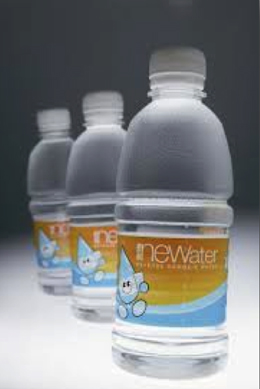 Water from waste water in SingaporeIn Singapore, over the last 25 years the rivers and streams have been cleaned, the sewer system advanced to reach 100 % of the population, and a NEWater program which effectively collects and cleans wastewater –surpassing international drinking water standards, implemented. Singapore will ramp up its NEWater and desalination capacity such that by 2060 they will account for 80 per cent of Singapore's water demand.
Water from waste water in SingaporeIn Singapore, over the last 25 years the rivers and streams have been cleaned, the sewer system advanced to reach 100 % of the population, and a NEWater program which effectively collects and cleans wastewater –surpassing international drinking water standards, implemented. Singapore will ramp up its NEWater and desalination capacity such that by 2060 they will account for 80 per cent of Singapore's water demand.
India
 Dr. Bindeshwar Pathak with the Sulabh International Social Service Organization
Dr. Bindeshwar Pathak with the Sulabh International Social Service Organization
In India, Dr. Bindeshwar Pathak with the Sulabh International Social Service Organization, has built more than 1.2 million two-pit pour-flush toilets and over 7,000 pay-for use toilet complexes serving more than 10 million people a day in India and Afghanistan. They are eco-friendly, technologically appropriate, socio-culturally acceptable, and economically affordable.

The public toilet complexes are open round the clock with bathrooms, lockers, and private toilets. They use duckweed-based wastewater treatment. Pisciculture and a new technology, an aerobic composter, are part of their innovative efforts.
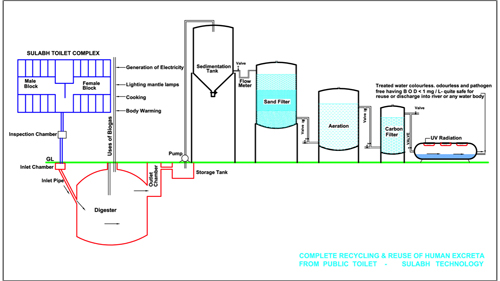 They use duckweed-based wastewater treatment.: They use duckweed-based wastewater treatment. Pisciculture and a new technology, an aerobic composter, are part of their innovative efforts.
They use duckweed-based wastewater treatment.: They use duckweed-based wastewater treatment. Pisciculture and a new technology, an aerobic composter, are part of their innovative efforts.
Among the new approaches for improving sanitation and hygiene is Community-Led Total Sanitation, a community-wide participatory approach to improve sanitation based on stimulating a collective sense of disgust and shame.
Thailand
And, in Thailand 99.9 % of the rural population reported having a sanitary toilet.
 Health improvements came from securing toilets in Thailand.
Health improvements came from securing toilets in Thailand.
Mexico
After 25 years of bringing about health reform through “combined implementation …of several efforts to strengthen the health system and various disease-oriented strategies, Mexico is on track to achieve MDG 4 -- to reduce their child mortality rate by two-thirds no later than 2015. Briefly, as described by Drs. Julio Frenk and Octavio Gómez-Dantés, this came about as a result of extending access to primary health care with expanded public supply of clinical services complemented with implementation of major community-based programs to address the challenges related to common infections, malnutrition, and maternal and child health.” Access to improved sanitation facilities and to improved drinking water sources were major factors.
Realizing Water, Sanitation and Hygiene for All
Article 2 features meeting sanitation and hygiene needs with the help of the communities themselves and assistance from the WSSCC’s Global Sanitation Fund.
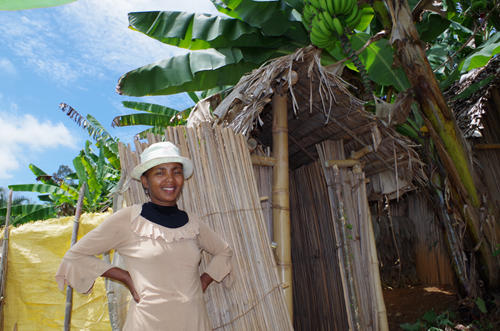 Marceline, had her husband build the family’s first latrine in 2013. In this region in the East of Madagascar: more than 800 villages now have latrines for every household thanks to support from the Global Sanitation Fund programme. Photograph c WSSCC/Katherine Anderson
Marceline, had her husband build the family’s first latrine in 2013. In this region in the East of Madagascar: more than 800 villages now have latrines for every household thanks to support from the Global Sanitation Fund programme. Photograph c WSSCC/Katherine Anderson
Among the new approaches for improving sanitation and hygiene is Community-Led Total Sanitation (CLTS), a community-wide participatory approach to improve sanitation based on stimulating a collective sense of disgust and shame.
“The Madagascar programme focuses on hygiene education, raising awareness and demand-creation in order to have an impact on a national scale,” according to WSSCC. “The regional approach combines promotion of hygiene, community-led total sanitation (CLTS) and sanitation marketing. The vision for all selected regions is to attain ODF [Open Defecation Free] status, as well as for local governments in the targeted areas to maintain a designated sanitation budget, improve capacity for sanitation and hygiene promotion and promote access to a vibrant private sector providing improved sanitation.”
This article was published on the Horizon International Solutions Site 30 January 2014.
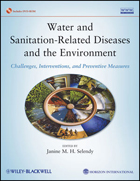 Book CoverThis article is presented as part of the Supplementary Material that accompanies the book Water and Sanitation Related Diseases and the Environment: Challenges, Interventions, and Preventive Measures, a Wiley-Blackwell publication in collaboration with Horizon International, written by 59 experts. Janine M. H. Selendy, Horizon International Founder, Chairman, President and Publisher, is Editor.
Book CoverThis article is presented as part of the Supplementary Material that accompanies the book Water and Sanitation Related Diseases and the Environment: Challenges, Interventions, and Preventive Measures, a Wiley-Blackwell publication in collaboration with Horizon International, written by 59 experts. Janine M. H. Selendy, Horizon International Founder, Chairman, President and Publisher, is Editor.
The book’s 4 hours of multimedia DVDs are included with an abundance of multidisciplinary resources, covering diverse topics from anthropology to economics to global health are being distributed free of charge by the Global Development And Environment Institute (GDAE) at Tufts University.
These are being given to thousands of libraries, organizations, and institutions in 138 less-wealthy countries. They are valuable additions to resources for use in classrooms and communities, by researchers and government decision-makers.
 Map of countries
Map of countries
As of 30 January 2014, these resources have been made available in over 1,300 entities in 60 countries.
Read more: PDF Version is available at http://solutions-site.org/press/release1july2013.pdf
Search
Latest articles
Agriculture
- World Water Week: Healthy ecosystems essential to human health: from coronavirus to malnutrition Online session Wednesday 24 August 17:00-18:20
- World Water Week: Healthy ecosystems essential to human health: from coronavirus to malnutrition Online session Wednesday 24 August 17:00-18:20
Air Pollution
- "Water and Sanitation-Related Diseases and the Changing Environment: Challenges, Interventions, and Preventive Measures" Volume 2 Is Now Available
- Global Innovation Exchange Co-Created by Horizon International, USAID, Bill and Melinda Gates Foundation and Others
Biodiversity
- It is time for international mobilization against climate change
- World Water Week: Healthy ecosystems essential to human health: from coronavirus to malnutrition Online session Wednesday 24 August 17:00-18:20
Desertification
- World Water Week: Healthy ecosystems essential to human health: from coronavirus to malnutrition Online session Wednesday 24 August 17:00-18:20
- UN Food Systems Summit Receives Over 1,200 Ideas to Help Meet Sustainable Development Goals
Endangered Species
- Mangrove Action Project Collaborates to Restore and Preserve Mangrove Ecosystems
- Coral Research in Palau offers a “Glimmer of Hope”
Energy
- Global Innovation Exchange Co-Created by Horizon International, USAID, Bill and Melinda Gates Foundation and Others
- Wildlife Preservation in Southeast Nova Scotia
Exhibits
- Global Innovation Exchange Co-Created by Horizon International, USAID, Bill and Melinda Gates Foundation and Others
- Coral Reefs
Forests
- NASA Satellites Reveal Major Shifts in Global Freshwater Updated June 2020
- Global Innovation Exchange Co-Created by Horizon International, USAID, Bill and Melinda Gates Foundation and Others
Global Climate Change
- It is time for international mobilization against climate change
- It is time for international mobilization against climate change
Global Health
- World Water Week: Healthy ecosystems essential to human health: from coronavirus to malnutrition Online session Wednesday 24 August 17:00-18:20
- More than 400 schoolgirls, family and teachers rescued from Afghanistan by small coalition
Industry
- "Water and Sanitation-Related Diseases and the Changing Environment: Challenges, Interventions, and Preventive Measures" Volume 2 Is Now Available
- Global Innovation Exchange Co-Created by Horizon International, USAID, Bill and Melinda Gates Foundation and Others
Natural Disaster Relief
- STOP ATTACKS ON HEALTH CARE IN UKRAINE
- Global Innovation Exchange Co-Created by Horizon International, USAID, Bill and Melinda Gates Foundation and Others
News and Special Reports
- World Water Week: Healthy ecosystems essential to human health: from coronavirus to malnutrition Online session Wednesday 24 August 17:00-18:20
- STOP ATTACKS ON HEALTH CARE IN UKRAINE
Oceans, Coral Reefs
- World Water Week: Healthy ecosystems essential to human health: from coronavirus to malnutrition Online session Wednesday 24 August 17:00-18:20
- Mangrove Action Project Collaborates to Restore and Preserve Mangrove Ecosystems
Pollution
- Zakaria Ouedraogo of Burkina Faso Produces Film “Nzoue Fiyen: Water Not Drinkable”
- "Water and Sanitation-Related Diseases and the Changing Environment: Challenges, Interventions, and Preventive Measures" Volume 2 Is Now Available
Population
- "Water and Sanitation-Related Diseases and the Changing Environment: Challenges, Interventions, and Preventive Measures" Volume 2 Is Now Available
- "Water and Sanitation-Related Diseases and the Changing Environment: Challenges, Interventions, and Preventive Measures" Volume 2 Is Now Available
Public Health
- Honouring the visionary behind India’s sanitation revolution
- Honouring the visionary behind India’s sanitation revolution
Rivers
- World Water Week: Healthy ecosystems essential to human health: from coronavirus to malnutrition Online session Wednesday 24 August 17:00-18:20
- Mangrove Action Project Collaborates to Restore and Preserve Mangrove Ecosystems
Sanitation
- Honouring the visionary behind India’s sanitation revolution
- Honouring the visionary behind India’s sanitation revolution
Toxic Chemicals
- "Water and Sanitation-Related Diseases and the Changing Environment: Challenges, Interventions, and Preventive Measures" Volume 2 Is Now Available
- Actions to Prevent Polluted Drinking Water in the United States
Transportation
- "Water and Sanitation-Related Diseases and the Changing Environment: Challenges, Interventions, and Preventive Measures" Volume 2 Is Now Available
- Urbanization Provides Opportunities for Transition to a Green Economy, Says New Report
Waste Management
- Honouring the visionary behind India’s sanitation revolution
- Honouring the visionary behind India’s sanitation revolution
Water
- Honouring the visionary behind India’s sanitation revolution
- Honouring the visionary behind India’s sanitation revolution
Water and Sanitation
- Honouring the visionary behind India’s sanitation revolution
- Honouring the visionary behind India’s sanitation revolution

